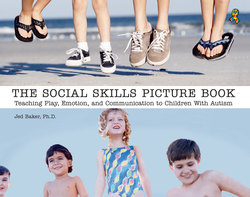Читать книгу The Social Skills Picture Book - Jed Baker PhD - Страница 12
На сайте Литреса книга снята с продажи.
Оглавлениеxi
THE NATURE OF AUTISM
A Brief Look at Autism
Autism
is a term used to describe a wide range of symptoms that span an individual’s sensory, cognitive, motor,
language, and social-emotional development. Current diagnostic criteria characterize autism as involving deficits in
three general areas: (a) social interaction, (b) communication, and (c) repetitive and ritualistic behaviors (American
Psychiatric Association, 1994).
Problems with social interaction can include difficulties initiating or responding to communication or play, difficulties
using or responding to non-verbal gestures (e.g., pointing out objects), lack of or inconsistent eye contact, impairments
in responding to others’ feelings, and subsequent failure to develop peer relationships. Understanding what to do or say
in social situations is a core problem for autistic individuals.
Communication problems may include pragmatic, semantic, and structural language difficulties. Pragmatic language
refers to the social use of language, as is involved in sustaining or initiating communication. For example, some autistic
individuals may appear to have perfectly intact language in terms of their ability to express themselves and understand
others, yet they may have great trouble with social communication (e.g., talking at people instead of with people,
relaying factual information or phrases memorized from TV shows without responding to what their listener is saying or
doing). Many autistic individuals also have a semantic language problem involving trouble understanding the meaning
of words, especially with abstract words, metaphors, or sayings. For example, they may hear the saying “Don’t let the cat
out of the bag” and search for a cat and bag rather than grasp the symbolic meaning regarding not spoiling a surprise.
Structural language problems refer to difficulties with the use of grammar and syntax. Many autistic individuals may
have difficulty putting sentences together and understanding grammatically correct sentence structure.
Repetitive and ritualistic behaviors reflect a preference for sameness and repetition with regards to interests, daily
routine, and body movements. Many youngsters with autism develop a fascination with a particular area of interest and
elaborate on that interest, to the exclusion of learning about new things. For example, I knew a youngster who became
obsessed with vacuum cleaners and was reluctant to attend to or talk about anything else. Many autistic individuals
also exhibit non-functional routines that appear superstitious in nature. One youngster I worked with had to hang
every picture in the house at a crooked angle before he could use the toilet. Other youngsters might repetitively line up
toy blocks, letters, or numbers in a certain manner. Such autistic individuals may become very anxious or upset when
changes or transitions are introduced. Youngsters may also demonstrate repetition in their use of language (repeating
the same phrase over and over) or in their physical movements (e.g., repetitive hand flapping, body rocking, or twirling
around and around.)
